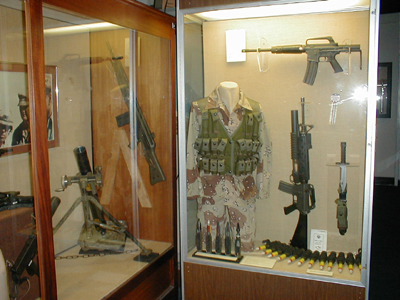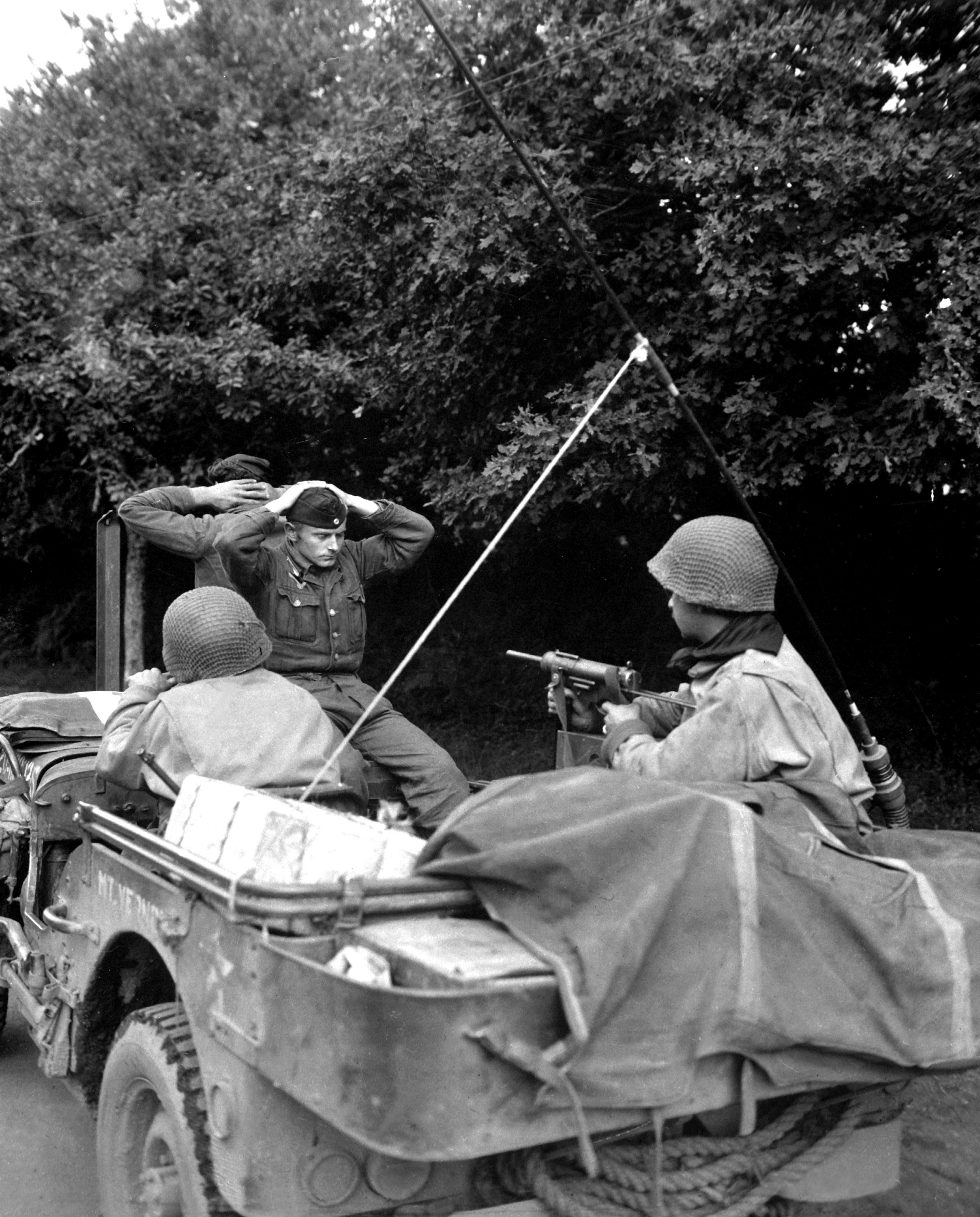|
M231 Firing Port Weapon
The M231 Firing Port Weapon (FPW) is an adapted version of the M16 assault rifle for shooting from firing ports on the M2 Bradley. The M16, standard infantry weapon of the time, was too long for use in a "buttoned up" APC, so the FPW was developed to provide a suitable weapon for this role. Designed by the Rock Island Arsenal, the M231 FPW remains in service. All but the rear two firing ports on the Bradley have been removed. History Work started in 1972 on a dedicated Firing Port Weapon to go along with the Mechanized Infantry Combat Vehicle (MICV) program also started at that time. A requirement for these vehicles was to have firing ports for troops riding inside, and so it was decided that a specific weapon also be developed. The Rock Island Arsenal headed up the project working with the M3 submachine gun (a World War II-era SMG), a Firing Port Weapon created by Heckler & Koch based on the HK33, and a modified M16 rifle pattern weapon. The qualities of the M16 were the m ... [...More Info...] [...Related Items...] OR: [Wikipedia] [Google] [Baidu] |
Firing Port
A firing port, sometimes called a pistol port, is a small opening in armored vehicles, fortified structures like bunkers, or other armored equipment that allows small arms to be safely fired out of the vehicle at enemy infantry, often to cover vehicle or building blindspots. Examples of this can be seen in the Crusader tank, Sherman tank, Tiger I, T-34-85, and even modern armored vehicles today such as the Mechanized Infantry Combat Vehicle (MICV) program, its successor the Bradley Fighting Vehicle (BFV) featuring the M231 Firing Port Weapon, and Russian armored personnel carriers. Some firing ports are improvised for such use. For example a late production Tiger I manual shows the Nahverteidigungswaffe being used as a firing port. Some pistol ports, such as on the Sherman, included vision slits such as "protectoscopes" increasing visibility around the tank. Ballistic weakspot Being a ballistic weak spot, firing ports are often reinforced with additional armor, and in sub ... [...More Info...] [...Related Items...] OR: [Wikipedia] [Google] [Baidu] |
Rock Island Arsenal
The Rock Island Arsenal comprises , located on Arsenal Island, originally known as Rock Island, on the Mississippi River between the cities of Davenport, Iowa, and Rock Island, Illinois. It lies within the state of Illinois. Rock Island was previously used as the summer camp site for Sauk Native Americans, and the dispute over tribal ownership led to the Black Hawk War of 1832, after the primary leader of the Sauk, Black Hawk. It is now home of First Army headquarters, and the US Army's Center of Excellence for Additive Manufacturing. ASA(ALT)br>Assistant Secretary of the Army (Acquisition, Logistics and Technology) (Friday, October 4, 2019) Army Advanced Manufacturing InitiativeRyan McCarthy (18 September 2019) Army Directive 2019-29 (Enabling Readiness and Modernization Through Advanced Manufacturing)This directive is to be implemented by Materiel Command and Futures Command; the proponent will be ASA(ALT)Mark Esper (07 Dec 2018) Army Directive 2018-26 (Enabling ... [...More Info...] [...Related Items...] OR: [Wikipedia] [Google] [Baidu] |
Cold War Firearms Of The United States
Cold is the presence of low temperature, especially in the atmosphere. In common usage, cold is often a subjectivity, subjective perception. A lower bound to temperature is absolute zero, defined as 0.00K on the Kelvin scale, an absolute thermodynamic temperature scale. This corresponds to on the Celsius scale, on the Fahrenheit scale, and on the Rankine scale. Since temperature relates to the thermal energy held by an object or a sample of matter, which is the kinetic energy of the random motion of the particle constituents of matter, an object will have less thermal energy when it is colder and more when it is hotter. If it were possible to cool a system to absolute zero, all motion of the particles in a sample of matter would cease and they would be at complete rest in the classical physics, classical sense. The object could be described as having zero thermal energy. Microscopically in the description of quantum mechanics, however, matter still has zero-point energy ... [...More Info...] [...Related Items...] OR: [Wikipedia] [Google] [Baidu] |
List Of Individual Weapons Of The U
A ''list'' is any set of items in a row. List or lists may also refer to: People * List (surname) Organizations * List College, an undergraduate division of the Jewish Theological Seminary of America * SC Germania List, German rugby union club Other uses * Angle of list, the leaning to either port or starboard of a ship * List (information), an ordered collection of pieces of information ** List (abstract data type), a method to organize data in computer science * List on Sylt, previously called List, the northernmost village in Germany, on the island of Sylt * ''List'', an alternative term for ''roll'' in flight dynamics * To ''list'' a building, etc., in the UK it means to designate it a listed building that may not be altered without permission * Lists (jousting), the barriers used to designate the tournament area where medieval knights jousted * ''The Book of Lists'', an American series of books with unusual lists See also * The List (other) * Listing (di ... [...More Info...] [...Related Items...] OR: [Wikipedia] [Google] [Baidu] |
Chauchat-Ribeyrolles 1918 Submachine Gun
The Chauchat-Ribeyrolles 1918 submachine gun is a French prototype automatic weapon. In 1917, the French Army adopted the Mle. 1917 semi-automatic rifle made by Ribeyrolles, Sutter and Chauchat (RSC), who already developed the "Chauchat" Mle. 1915 LMG. In 1918, they presented a "pistolet-mitrailleur" (submachine gun), meant to be used for close-range protection for the French tank crews. The weapon is based on the RSC Mle. 1917 semi-automatic rifle mechanism. The first trials used a Mannlicher–Berthier clip holding eight cartridges. The trials continued until 1919 with a weapon using the same magazine as the Chauchat. The results were satisfactory but the weapon was too powerful for the intended self-protection use. A mix of standard and tracer bullets was planned to be used to assist in aiming. See also * Ribeyrolles 1918 automatic carbine * M231 Firing Port Weapon The M231 Firing Port Weapon (FPW) is an adapted version of the M16 assault rifle for shooting from f ... [...More Info...] [...Related Items...] OR: [Wikipedia] [Google] [Baidu] |
HK33
The Heckler & Koch HK33 is a 5.56mm assault rifle developed in the 1960s by West German armament manufacturer Heckler & Koch GmbH (H&K), primarily for export. Building on the success of their G3 design, the company developed a family of small arms (all using the G3 operating principle and basic design concept) consisting of four types of firearms: the first type, chambered in 7.62×51mm NATO; the second, using the Soviet 7.62×39mm M43 round; the third, chambered in .223 Remington and 5.56×45mm NATO; and the fourth type, chambered for the 9×19mm Parabellum pistol cartridge. Commercially the HK33 was a successful design but it did not sell as well as the G3. The HK33 series of rifles were adopted by the Brazilian Air Force (''Força Aérea Brasileira'' or FAB), the armed forces of Thailand and Malaysia where they were produced under a licence agreement. The rifle was also licence-built in Turkey by MKEK, and exported from France branded as MAS but actually made in Germa ... [...More Info...] [...Related Items...] OR: [Wikipedia] [Google] [Baidu] |
Heckler & Koch
Heckler & Koch GmbH (HK; ) is a German defense manufacturing company that manufactures handguns, rifles, submachine guns, and grenade launchers. The company is located in Oberndorf am Neckar in the German state of Baden-Württemberg, and also has subsidiaries in the United Kingdom, France and the United States. The Heckler & Koch Group comprises Heckler & Koch GmbH, Heckler & Koch Defense, NSAF Ltd., and Heckler & Koch France SAS. The company's motto is "''Keine Kompromisse!''" (No Compromises!). HK provides firearms for many military and paramilitary units, including the SAS, KMar, the US Navy SEALs, Delta Force, HRT, Canada's Joint Task Force 2, the German KSK and GSG 9, and many other counter-terrorist and hostage rescue teams. Their products include the MP5, UMP submachine guns, the G3, HK417 battle rifles, the HK33, G36, HK416 assault rifles, the MG5, HK21 General-purpose machine guns, the MP7 personal defense weapon, the USP series of handguns, and the PSG1 ... [...More Info...] [...Related Items...] OR: [Wikipedia] [Google] [Baidu] |
M3 Submachine Gun
The M3 is an American .45-caliber submachine gun adopted by the U.S. Army on 12 December 1942, as the United States Submachine Gun, Cal. .45, M3.Iannamico, Frank, ''The U.S. M3-3A1 Submachine Gun'', Moose Lake Publishing, , (1999), pp. 14, 22–24, 34–39, 44–46, 54–55, 59–63, 67, 73–74 The M3 was chambered for the same .45 ACP round fired by the Thompson submachine gun, but was cheaper to mass produce and lighter, although, contrary to popular belief, it was less accurate. The M3 was commonly referred to as the "Grease Gun" or simply "the Greaser," owing to its visual similarity to the mechanic's tool.Ingram, Mike: ''The MP40 Submachine Gun'', p. 85. Zenith Imprint, 2001. The M3 was intended as a replacement for the Thompson, and began to enter frontline service in mid-1944. The M3A1 variant was used in the Korean War and later conflicts. The M14 rifle, adopted in 1959, was intended to replace the M3A1 (as well as the M1 Garand, M1918 Browning Automatic Rifle and th ... [...More Info...] [...Related Items...] OR: [Wikipedia] [Google] [Baidu] |
MICV-65
MICV-65, short for ''Mechanized Infantry Combat Vehicle, 1965'', was a US Army project that studied a number of armored fighting vehicles that would replace the M113 and M114 as well as take on a variety of new roles. A number of designs were studied as part of the MICV project, but none of them entered service for a variety of reasons. Nevertheless, experience gained in the MICV project eventually led to the M2 Bradley, which incorporates many of the MICV concepts. Background World War II opened with the concepts of armored warfare relatively undeveloped. Infantry and armor were generally organized as separate units, which led to problems when the armor would outrace the infantry and then have to stop at various obstacles like rivers or strongpoints. As the war progressed the doctrine of combined arms became better refined, and the need for specialist vehicles to keep the infantry in close contact with the armor became increasingly important. Most of these vehicles were half- ... [...More Info...] [...Related Items...] OR: [Wikipedia] [Google] [Baidu] |
M2 Bradley
The M2 Bradley, or Bradley IFV, is an American infantry fighting vehicle that is a member of the Bradley Fighting Vehicle family. It is manufactured by BAE Systems Land & Armaments, which was formerly United Defense. The Bradley is designed for reconnaissance and to transport a squad of infantry, providing them protection from small arms fire, while also providing firepower to both suppress and eliminate most threats to friendly infantry. It is designed to be highly maneuverable and to be fast enough to keep up with heavy armor during an advance. The M2 holds a crew of three: a commander, a gunner, and a driver, as well as six fully equipped soldiers as passengers. In the year 2000 the total cost of the program was $5,664,100,000 for 1,602 units, giving an average unit cost of $3,166,000, or $5,500,000 per in 2022. Design The Bradley IFV was developed largely in response to the amphibious Soviet BMP family of infantry fighting vehicles, and to serve as both an armored perso ... [...More Info...] [...Related Items...] OR: [Wikipedia] [Google] [Baidu] |





